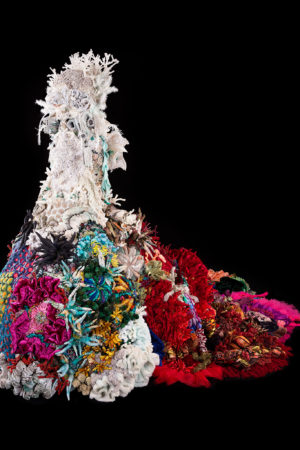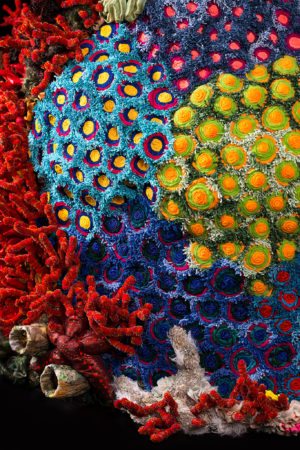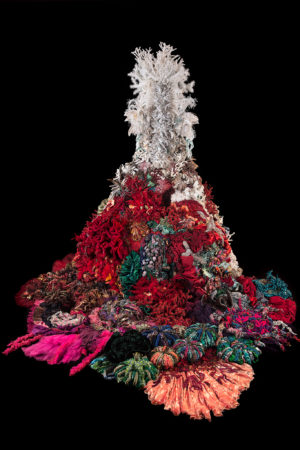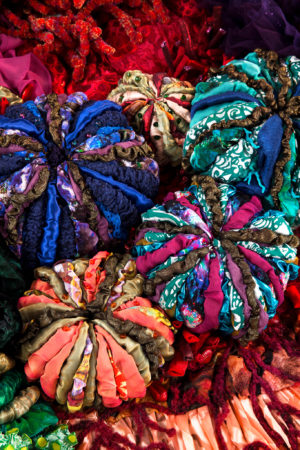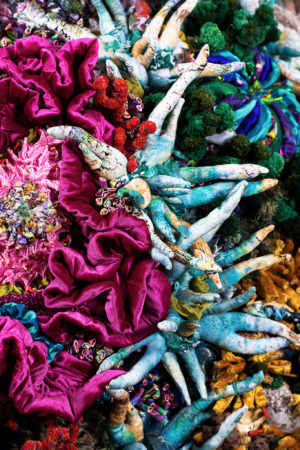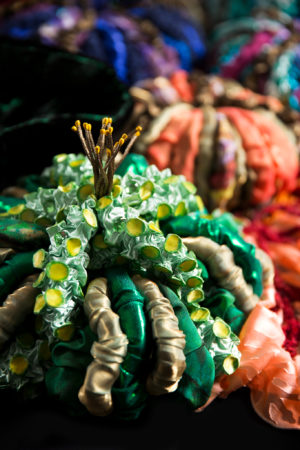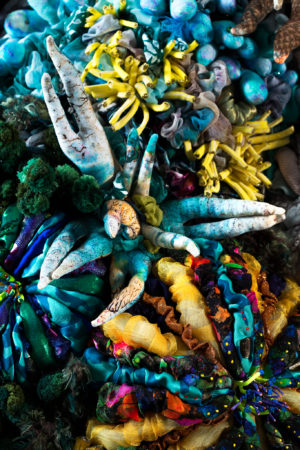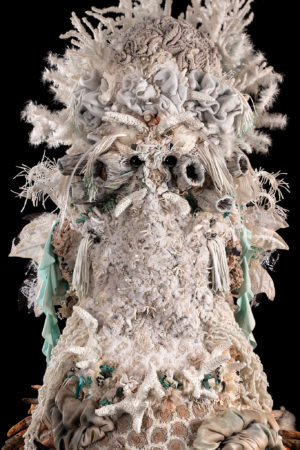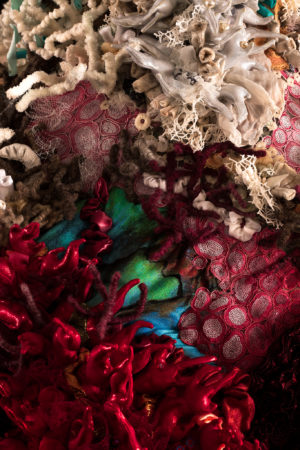Above: Evanescent a Textile and Mixed Media sculpture about the impact of climate change on coral reefs. 2016 – 2018, 200 x 400 cm
Italian artist Paola Idrontino is based near Barcelona and uses a range of techniques including hand and machine embroidery as well as photography to create wearable art and multi media installations depicting a story or a theme. This stunning piece Evanescent highlights the crisis our coral reefs are experiencing.
What is your background in textiles?
I’ve always been fascinated by the idea of transforming beautiful pieces of fabric into crazy textural garments. When I was fourteen, I began sewing and experimenting with making my own clothes for my own enjoyment. I was interested in exploring new ways of highlighting the natural silhouette of the body using garments. I saw a lot of potential in my artistic expression with textile. When I was 20 I moved to London to study art and design and in 2004, I completed a degree in Graphic Design at Central St Martins. My final project was a poster and video campaign about domestic violence, in which I used a sewing machine to create embroidered letters that formed the violent abuses that some have been subjected to in their home.
You do a few different types of art including photography. What is it about textiles that appeals to you?
When I use the word textile to describe my work, I prefer to say that my work uses fabric as one of the main elements. The combination of various textures result in playful and unexpected contrasts. My passion for accessories, costume design, and marine-inspired textile art finally merges with my photography which I can describe as my final combining agent that allows all what I do to come together as another level of art form.
What textile techniques do you use?
I use both hand stitches and machine embroidery techniques. I recently purchased a better sewing machine which has lots of different types of stitches. I love hand stitching though, because it allows precision and control at the same time. Depending on what fits with the idea, I use the technique that feels right to me depending on what type of fabric I am working with. Beadwork is also my favourite thing to use as embellishment in my work, and that can only be done by hand.
How do you describe your art?
Whimsical, bizarre, otherworldly, and grotesque.
How do you work?
When I have a vision for a new piece, I generally try not to sketch, unless I’m working with someone else and sketching is the only way I can convey my message across. It is difficult to sketch all the details of a costume that I am thinking about. I feel that once the idea is drawn down on a piece of paper, suddenly it has been restricted to a confined space. My preferred way of working is more playful. I like digging into my fabric bins and fishing out fabrics that inspire me and just start making things with it. I recycle lots of things and when I have in mind something more specific, I go to purchase fabric that is as close as possible to my vision. The textile samples sometimes become part of the final piece. My computer is usually only used to edit my photography.
How long does a piece take from start to finish?
Let’s say that my textile wearable costumes can take approximately up to three months to complete. For example, Evanescent, a 200 x 400cm textile sculpture about the impact of climate change on coral reefs, took two years to complete.
What are you most proud of so far?
I take pride when creating elaborate pieces filled with lots of details. I am proud to have been able to show my work in various galleries and museums, and to have been able to collaborate with incredible people along the way. I am grateful that I can do what I do and completely dedicate my time in continuing to develop my skills and to see my work growing into new directions.
Do you have any advice for aspiring textile artists?
My advice to fellow textile artist would be to play fearlessly. Share your work, techniques and work development with others. Flow and enjoy!
Do you have any upcoming exhibitions you would like to share?
I am preparing for a solo show at Les Bernardes in Girona, which opens November 8th 2019, and will remain open for two months. This show will be called Breathing Waves – a body of work about the beauty of our world’s oceans and the impact of coral bleaching caused by climate change.
https://www.instagram.com/paolaidrontinoart



